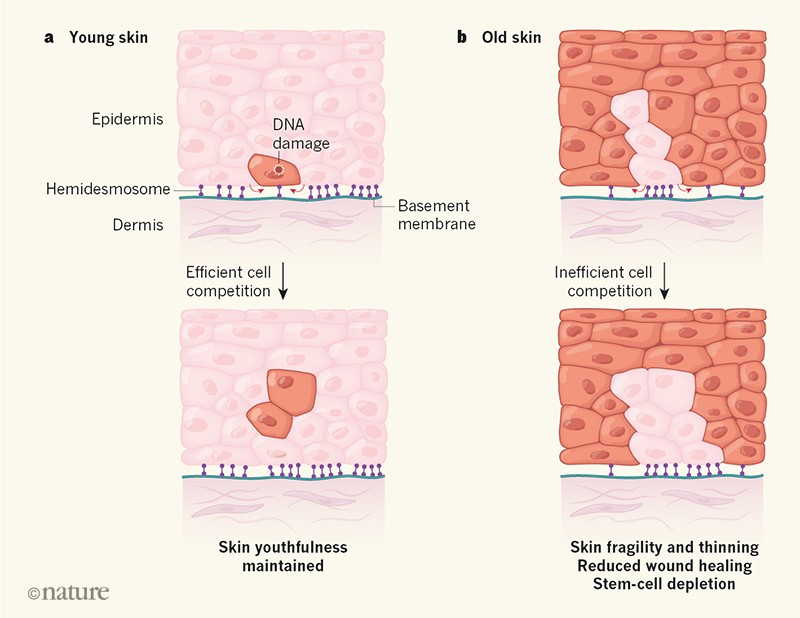Cell competition in the skin promotes tissue youthfulness, but the same process later leads to skin ageing. This finding helps to explain how skin is maintained, and uncovers potential anti-ageing therapeutic targets.
Charles Darwin referred1 to natural selection as “one general law, leading to the advancement of all organic beings, namely, multiply, vary, let the strongest live and the weakest die”. We now know that Darwin’s (and Alfred Russel Wallace’s) concept also applies to certain mechanisms that govern organ development, tissue maintenance and ageing. Just as different species compete for limited resources and space, so cells in a multicellular organism compete for a niche, and less-fit cells are eliminated to keep tissues and organs ‘youthful’. Writing in Nature, Liu et al.2 provide insight into how tissue youthfulness is maintained, and which mechanisms drive the ageing process in epithelial organs such as the skin.
Natural selection has favoured tissue-maintenance programs that delay the decline of an animal’s body while the individual is likely to be able to reproduce successfully3. After that reproductive period, tissue-maintenance programs gradually lose their ability to mitigate the accumulation of damage to stem cells and their niches. This eventually leads to loss of tissue function and individual fitness, features that characterize ageing. Human ageing is prevalent in modern industrialized environments in which external threats to survival are negligible. Liu et al. used the tail skin of mice as a model for the ageing of human skin.
The skin of mammals consists of two compartments — an upper, multi-layered, stratified epithelium known as the epidermis and a deeper, thick layer of connective tissue called the dermis4. A thin layer of extracellular proteins, called the basement membrane, connects these two compartments. The cells in the epidermis are continuously renewed with cells that differentiate from stem cells and other progenitor cells located in the deepest layer of the epidermis — the basal layer. These basal-layer cells are anchored to the basement membrane through highly specialized multiprotein structures called hemidesmosomes4.
The protein known as type XVII collagen is one of the main components of hemidesmosomes. Reduced levels of this type of collagen (encoded by the gene COL17A1, and thus known as the COL17A1 protein) are a hallmark of ageing skin5. Liu et al. show that the number of hemidesmosomes in the tail skin of mice diminishes with age, and that this reduction correlates with low levels of COL17A1. Loss of COL17A1 destabilizes other hemidesmosome components and, eventually, prevents the formation of these structures. Liu et al. go on to show that COL17A1 is the least stable component of hemidesmosomes in mice and also in human epidermal cells in culture. COL17A1 rapidly degrades in response to several types of stress, including DNA damage resulting from exposure to ultraviolet light.
Liu et al. also traced the fate of basal-layer epidermal cells in mice. As these animals age, epidermal stem cells that express high levels of COL17A1 preferentially propagate at the expense of stem cells with low levels of COL17A1, and this makes the epidermal cells more clonal (that is, they originate from fewer different stem cells). This finding is consistent with the observation that blood cells in elderly humans are more clonal than those in younger individuals6.
The authors then used a mouse model in which COL17A1 expression could be switched off in a limited number of basal-layer epidermal cells. Loss of COL17A1 in a few epidermal stem cells triggered cell competition for space in the basal layer. ‘Unfit’ cells with low COL17A1 levels did not die, but they were pushed away from the basal layer and replaced by ‘fit’ cells that expressed high levels of COL17A1 (Fig. 1). Experiments using an in vitro model of human skin corroborated these findings. Reducing COL17A1 expression in basal epidermal cells resulted in the detachment of these cells from the basement membrane when a sufficient number of cells expressing high levels of COL17A1 were present to compete with the cells expressing low levels of COL17A1.
Natural selection has favoured tissue-maintenance programs that delay the decline of an animal’s body while the individual is likely to be able to reproduce successfully3. After that reproductive period, tissue-maintenance programs gradually lose their ability to mitigate the accumulation of damage to stem cells and their niches. This eventually leads to loss of tissue function and individual fitness, features that characterize ageing. Human ageing is prevalent in modern industrialized environments in which external threats to survival are negligible. Liu et al. used the tail skin of mice as a model for the ageing of human skin.
The skin of mammals consists of two compartments — an upper, multi-layered, stratified epithelium known as the epidermis and a deeper, thick layer of connective tissue called the dermis4. A thin layer of extracellular proteins, called the basement membrane, connects these two compartments. The cells in the epidermis are continuously renewed with cells that differentiate from stem cells and other progenitor cells located in the deepest layer of the epidermis — the basal layer. These basal-layer cells are anchored to the basement membrane through highly specialized multiprotein structures called hemidesmosomes4.
The protein known as type XVII collagen is one of the main components of hemidesmosomes. Reduced levels of this type of collagen (encoded by the gene COL17A1, and thus known as the COL17A1 protein) are a hallmark of ageing skin5. Liu et al. show that the number of hemidesmosomes in the tail skin of mice diminishes with age, and that this reduction correlates with low levels of COL17A1. Loss of COL17A1 destabilizes other hemidesmosome components and, eventually, prevents the formation of these structures. Liu et al. go on to show that COL17A1 is the least stable component of hemidesmosomes in mice and also in human epidermal cells in culture. COL17A1 rapidly degrades in response to several types of stress, including DNA damage resulting from exposure to ultraviolet light.
Liu et al. also traced the fate of basal-layer epidermal cells in mice. As these animals age, epidermal stem cells that express high levels of COL17A1 preferentially propagate at the expense of stem cells with low levels of COL17A1, and this makes the epidermal cells more clonal (that is, they originate from fewer different stem cells). This finding is consistent with the observation that blood cells in elderly humans are more clonal than those in younger individuals6.
The authors then used a mouse model in which COL17A1 expression could be switched off in a limited number of basal-layer epidermal cells. Loss of COL17A1 in a few epidermal stem cells triggered cell competition for space in the basal layer. ‘Unfit’ cells with low COL17A1 levels did not die, but they were pushed away from the basal layer and replaced by ‘fit’ cells that expressed high levels of COL17A1 (Fig. 1). Experiments using an in vitro model of human skin corroborated these findings. Reducing COL17A1 expression in basal epidermal cells resulted in the detachment of these cells from the basement membrane when a sufficient number of cells expressing high levels of COL17A1 were present to compete with the cells expressing low levels of COL17A1.

Figure 1 | Cell competition drives young and ageing skin dynamics. Liu et al.2 show that the collagen protein COL17A1 senses DNA damage. a, In young skin, DNA damage in a small number of epidermal stem cells promotes COL17A1 degradation (not shown) and impairs the formation of hemidesmosomes, the multiprotein structures that anchor basal-layer epidermal cells to the basement membrane connecting the epidermis to the dermis, the inner layer of the skin. Stem cells with high COL17A1 levels and high numbers of hemidesmosomes (‘fit’ cells) keep skin youthful by spreading along the basement membrane through parallel cell divisions and displacing (red arrows) poorly attached ‘less fit’ cells (orange) that have low COL17A1 levels. Less fit cells undergo perpendicular cell divisions that populate more-superficial layers of the skin, and are eventually shed. b, Ageing, radiation and certain genetic conditions cause a more general COL17A1 loss. If COL17A1 expression is restored in isolated stem cells, these cells divide and generate a patch of healthy skin. However, they cannot outcompete less fit cells across the entire skin. Stem-cell depletion, skin fragility and thinning, and reduced wound healing ensue.
The authors found that high levels of COL17A1 in mice promote stem-cell maintenance by stimulating basal-cell divisions on a plane parallel to that of the basement membrane. This mechanism explains the increasingly clonal characteristics of cells that express high levels of COL17A1 during ageing. Loss of COL17A1 stimulates divisions of basal-layer cells on a plane perpendicular to that of the basement membrane. These divisions are needed to produce differentiated epidermal cells of the non-basal layers of the skin.
However, too many of these perpendicular divisions eventually cause stem-cell depletion and other ageing-associated skin defects, such as epidermal thinning and depigmentation because of the loss of skin-pigment stem cells. When Liu and colleagues restored COL17A1 expression through genetic modification, this restored the ability of epidermal stem cells to compete within the basal layer and partially mitigated skin ageing.
Collectively, these results suggest that COL17A1 is a sensor of DNA damage and ageing in epidermal stem cells. In young skin, spontaneous DNA damage in a limited number of basal-layer cells promotes COL17A1 degradation, which, in turn, impairs hemidesmosome formation, reduces the cells’ adhesion to the basement membrane and triggers perpendicular cell division. Undamaged basal-layer cells with healthy, high levels of COL17A1 maintain parallel cell divisions and expand horizontally — thus effectively eliminating less fit cells from the basal layer and promoting skin youthfulness. A lifetime of damage to epidermal stem cells eventually reduces the overall level of COL17A1 to a critical threshold at which normal hemidesmosome formation is impaired. In this situation, there are fewer fit cells to compete with less-fit cells, and this leads to the depletion of skin stem cells, epidermal thinning and fragility, and skin depigmentation (Fig. 1).
The maintenance of fit stem cells through the years in which an individual is likely to reproduce probably also prevents tumour development, because these fit cells compete with (and eliminate) both damaged stem cells and tumour-prone cells7. Notably, cell competition has previously been shown to promote the expulsion from the epithelium of cells with tumour-causing mutations or other abnormal features8,9.
Although cell competition has been extensively studied in fruit flies10, Liu and colleagues’ work provides evidence that healthy cells in mammals can also efficiently repopulate adult tissues, replacing unfit or damaged cells. Similar competitive interactions between fit and unfit cells can sometimes be observed in people with an inherited skin disease called junctional epidermolysis bullosa (JEB), which is caused by mutations in genes that encode COL17A1 and other components of the dermal–epidermal junction11.
People with JEB have severe skin blistering because of structural abnormalities in their hemidesmosomes and dermal–epidermal junction11. Some affected individuals have reduced pigmentation at sites of healed blisters11 and have abnormally low numbers of skin stem cells12. The latter observation correlates with Liu and co-workers’ finding that proper adhesion of the epidermis to the basement membrane mediates the maintenance of skin stem cells. Notably, many, if not all, people with JEB caused by COL17A1 mutations have patches of normal, non-blistering skin that arise from a competitive expansion of cells in which the defect in COL17A1 has been spontaneously corrected13,14 — a form of natural gene therapy. These patches, dubbed ‘revertant skin patches’, have normal pigmentation13, which is consistent with the finding by Liu et al. that COL17A1 also plays a key part in the maintenance of skin-pigment stem cells.
In addition to elucidating the mechanisms of skin ageing, Liu et al.identify two chemicals that can induce COL17A1 expression in epidermal cells and improve the ability of skin stem cells to regenerate skin. Both chemicals improve wound healing in mouse tail skin, providing a proof-of-principle demonstration of the therapeutic potential of this new class of drug. Future studies are needed to determine the mechanisms of cell competition in other tissues, and to identify compounds capable of reversing ageing in other organs.
Source: https://www.nature.c...586-019-00825-3











































